Bryan Warren wrote about Martin Rollins’s 2017 “Town and Country Exhibition†at the BDeemer Gallery that “for those of us who make the city of Louisville and fields of Kentucky our home, Rollins’ images are places we know. The artist uses this familiarity to explore them, revealing a passionate interest in what we know and how we feel socially and historically, while maintaining a strong sense of the present. They are more than frozen moments. Instead, they are like fleeting memories playing on a loop.†Ray Kleinhelter’s subject matter is the Ohio River, rather than urban and suburban settings, but, like Rollins, Kleinhelter has an preternatural ability to make the familiar unfamiliar and the local transcendent. Warren also extolled “the tension between image and process†in Rollins’s work, and Kleinhelter as well re-orders the immediacy of topographical notation with a rigorous painterly logic and a firm notion of color-space. Both artists provide the special pleasure of re-envisioning for their viewers the local and familiar.
Ray Kleinhelter has two shows on view through May 4th, at the Kleinhelter Gallery at 8thand Culbertson in New Albany, and at Galerie Hertz at 1253 Preston in Louisville.
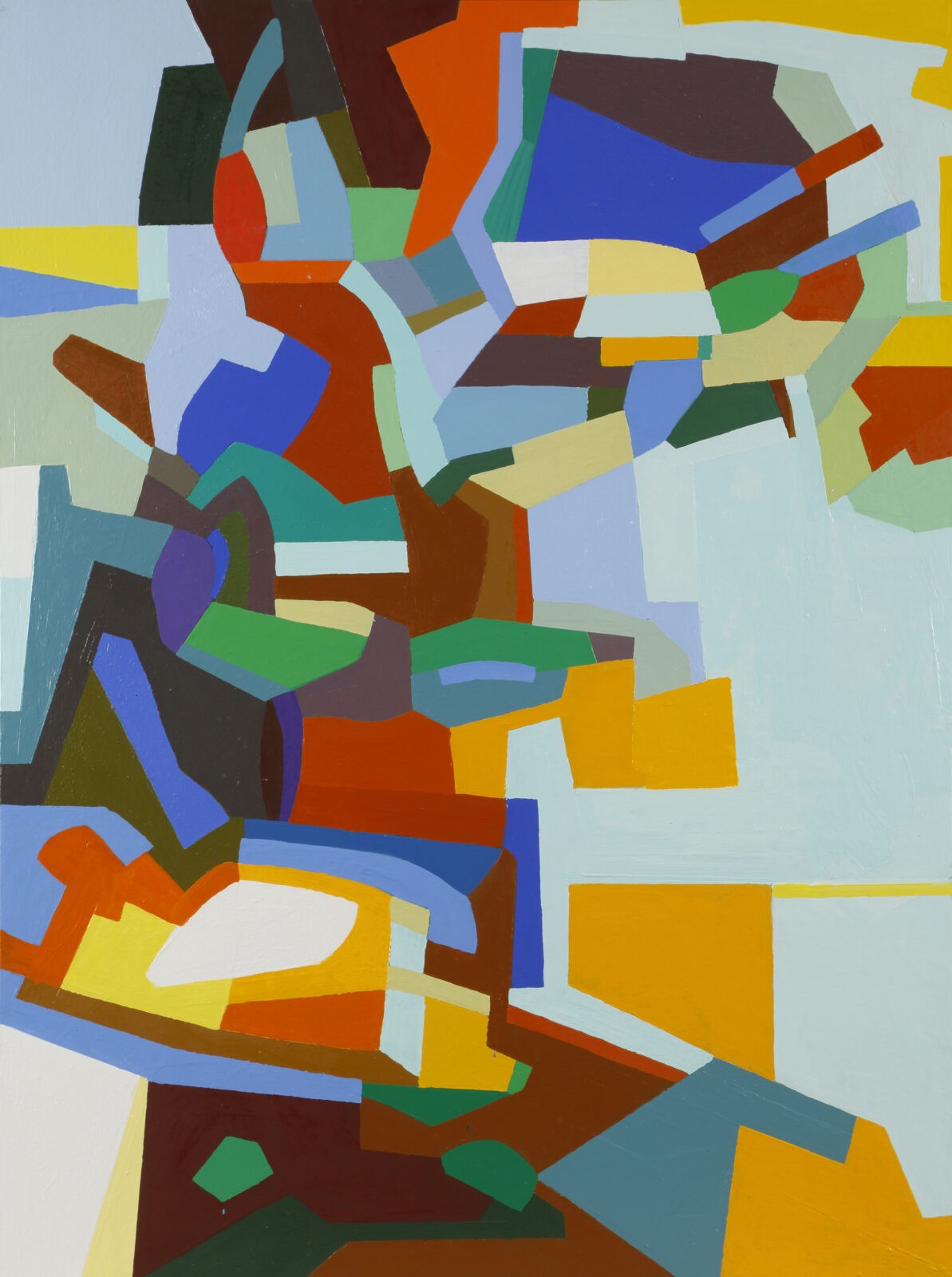
Kleinhelter’s recent evolution has been from a bejazzed jigsaw depiction of landscape with thickly-brushed saturated colors to a very open, bright palette of   startling hue gradations depicting clouds, sky, hillsides, banks and water. The older work had a Stuart Davis-like density and dynamism. Kleinhelter’s 2017 show at Sotheby’s Lenihan Real Estate, (up at the same time as Rollins’s), depicted riverscapes with dissonant color chords and strong light-dark contrasts, for example in “Riverbank #20.†(oil on canvas, 48â€x36â€). Spare, concise pen and pencil drawings in that exhibition suggested a new direction.
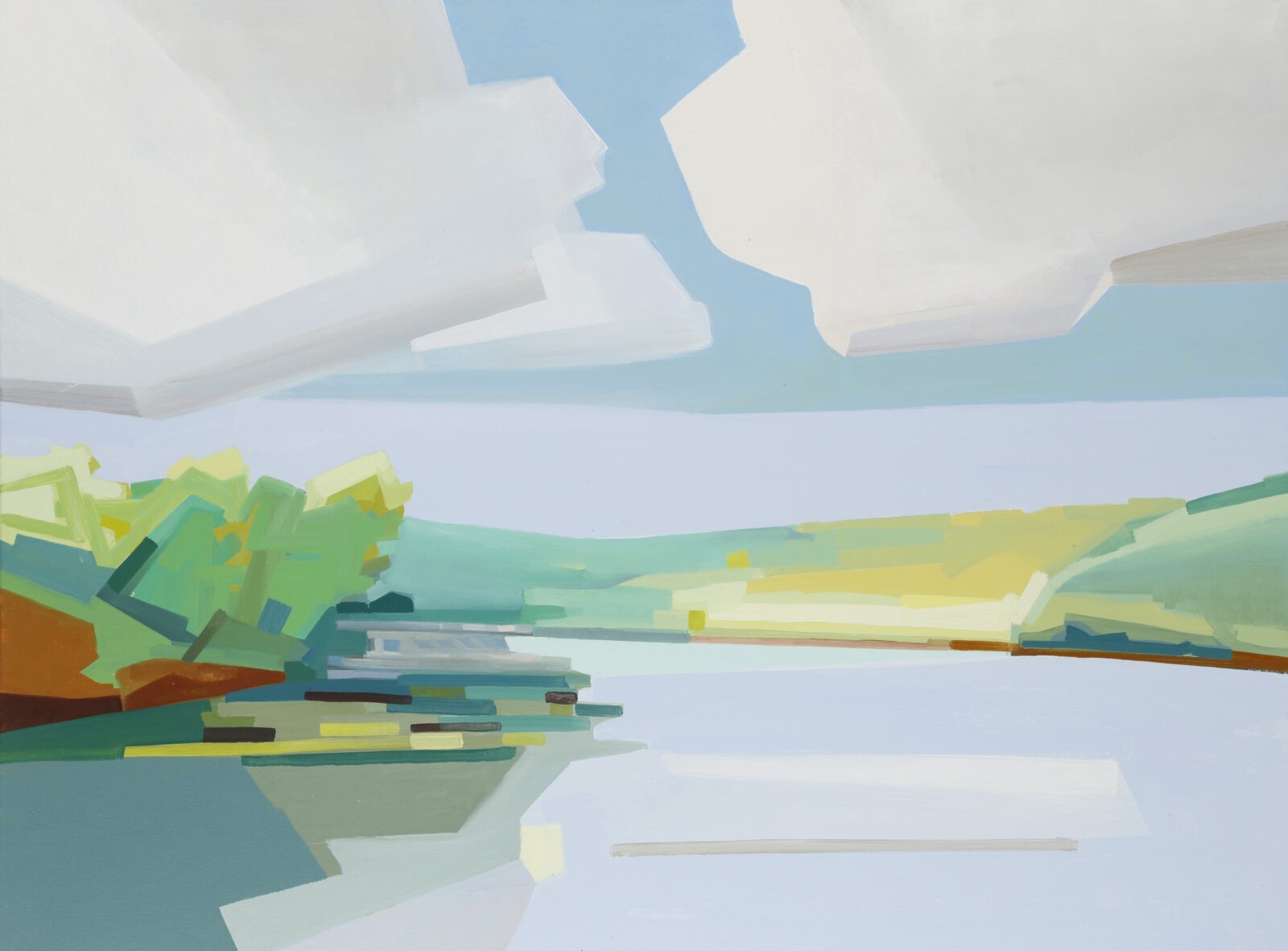
In his current work, Ray Kleinhelter still employs a geometricizing and generalizing translation of visual data into a language of interlocking trapezoids and rectangles, but at a very different tempo.  Sometimes these geometries overlap, as in “Liveaboard,†(oil on canvas, 30â€x40â€) creating a measured illusion of recession into the distance.  A compression of forms on the left contrasts with the expansive openness on the right. Colliding passages of yellow, orange, beige and mauve occupy the lower portion of this classically paced work and suggest not only the play of light and shade, and the reflection of clouds on the water, but also, the flow of the river’s current, and sun and sky as protagonists of this restrained, languid drama.
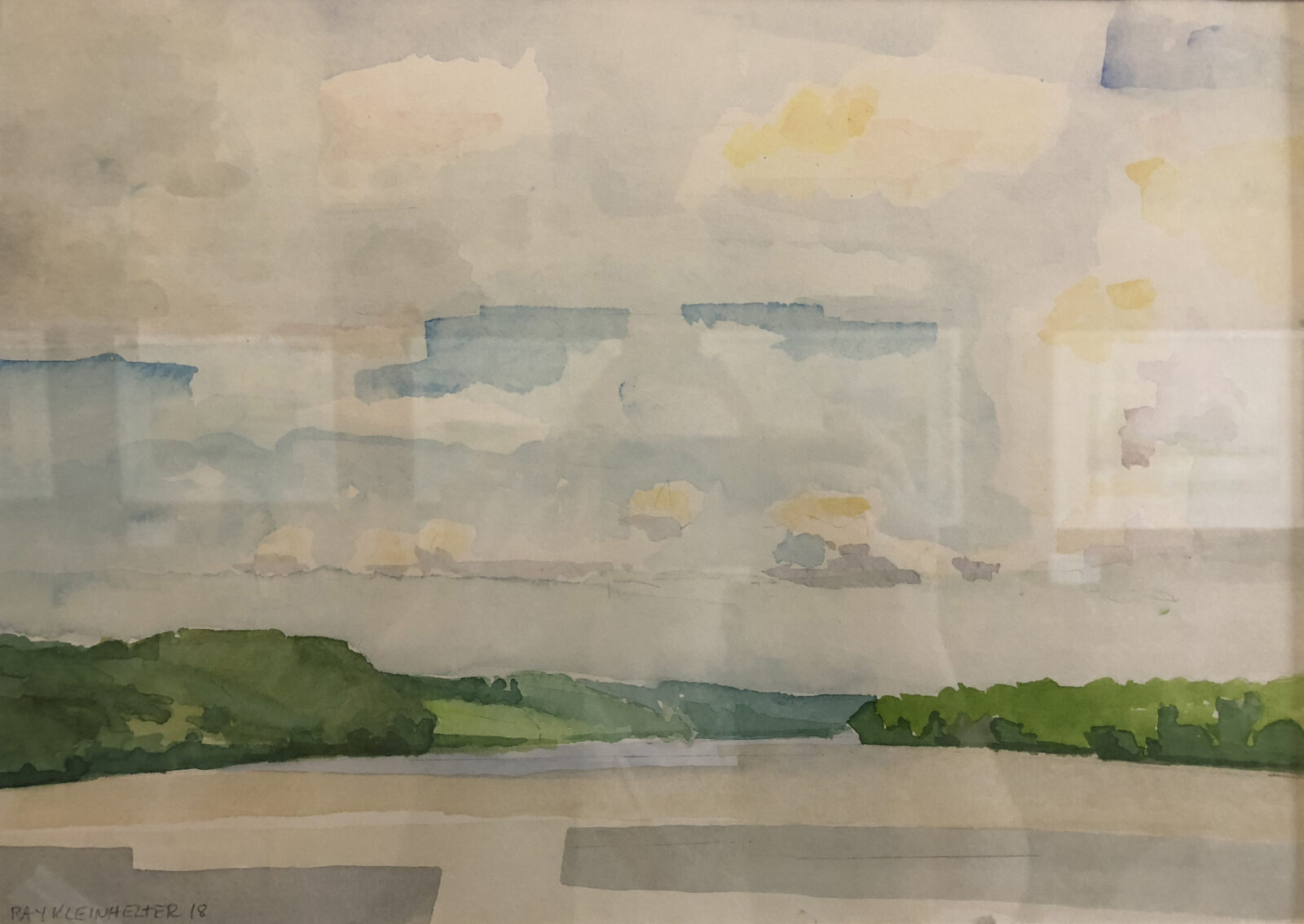
The watercolor study for “Mile 589†(watercolor, 10â€x14â€) is absorbed in describing particularities of place: the delicate inflections of the profiles of ridgelines, the drama of the sky and very intense observation of a range of hues in the landscape. The oil version is bolder and more emphatic, more open and more spacious.  (“Mile 589,†oil on canvas, 30â€x40â€). Although a depiction of nature, Kleinhelter’s vocabulary is very much of the moment: the sweep of the view is punctuated with right-angle geometries that evoke a machine part generated by a 3-D printer. Kleinhelter’s secondary and tertiary hues create a progression leading downriver in open water towards discoveries that lie beyond the next river bend.
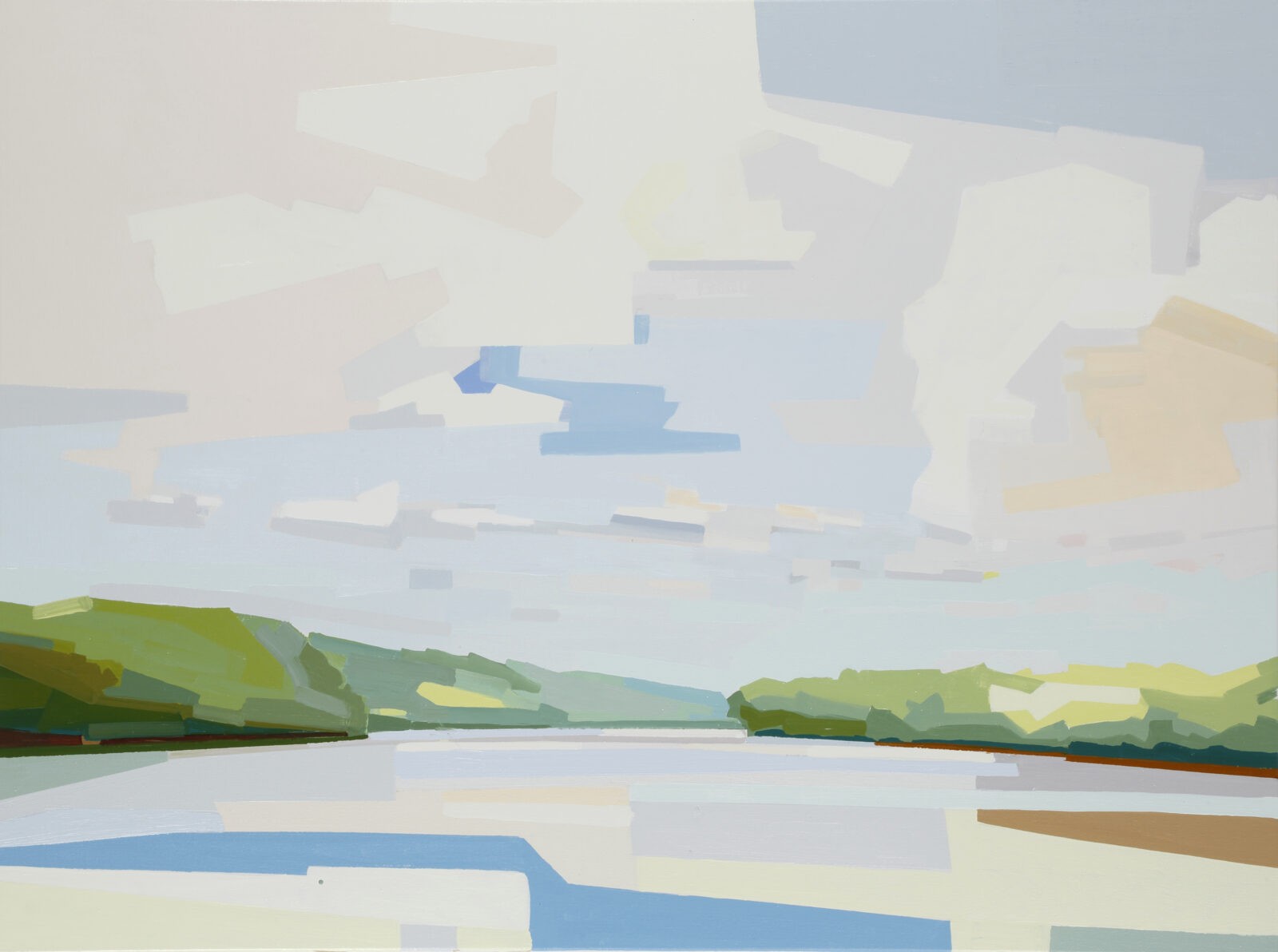
Ray Kleinhelter converted a cabin cruiser into a floating studio. He lives riverside and so his subject has a continual presence in his peripheral vision. There is ample art historical precedent for working from a boat: J.M.W. Turner often did views from an offshore perspective, the better to immerse the viewer in Romantic Era subject matter of storms or unusual light effects. The pre-Impressionist Charles Francois Daubigny converted a ferry to a floating studio from which he made etchings and paintings. Manet painted Monet and his wife in Monet’s floating studio, and Winslow Homer’s obsession with the power, cruelty and inconstancy of the Atlantic is one of the epic sustained narratives in American art.
What all of these artists’ practices have in common is an undermining of traditional perspective. The late Don Nice, who focused on the Hudson River in his art, noted, “The old or traditional approach of the Hudson River School painter was to break down the landscape in terms of foreground, middle ground and background. Painting from a boat eliminates the foreground, which minimizes the notion of Renaissance space.†The watery entry point at the lower edge of Kleinhelter’s compositions is both a field for abstract improvisation and a more accurate plein-airism: less explicit representation leads to a firmer and more complex concept of space, atmosphere and light. And what extraordinary light it is! Crystalline, lucid, a perfect match for a sense of freedom adrift. Planes of color glide together in different directions, sometimes off-kilter, being and un-being, forming and un-forming, like the motion of daylight itself. W. H. Auden, in his poem “A River Profile,†refers to “water, the selfless mother of all especials.â€
Kleinhelter’s geometric generalizing yields, ultimately, an uncanny specificity.
Kleinhelter’s new manner evolved from his works on paper, especially his watercolors aboard his floating studio. His painting practice was to cover every square inch of canvas, whereas his watercolor practice was exactly the opposite: to leave as much white space as possible. The delicacy of tints in the new oils and their unfinicky, elongated dashes and blocks preserves much of the spontaneity of the works on paper.
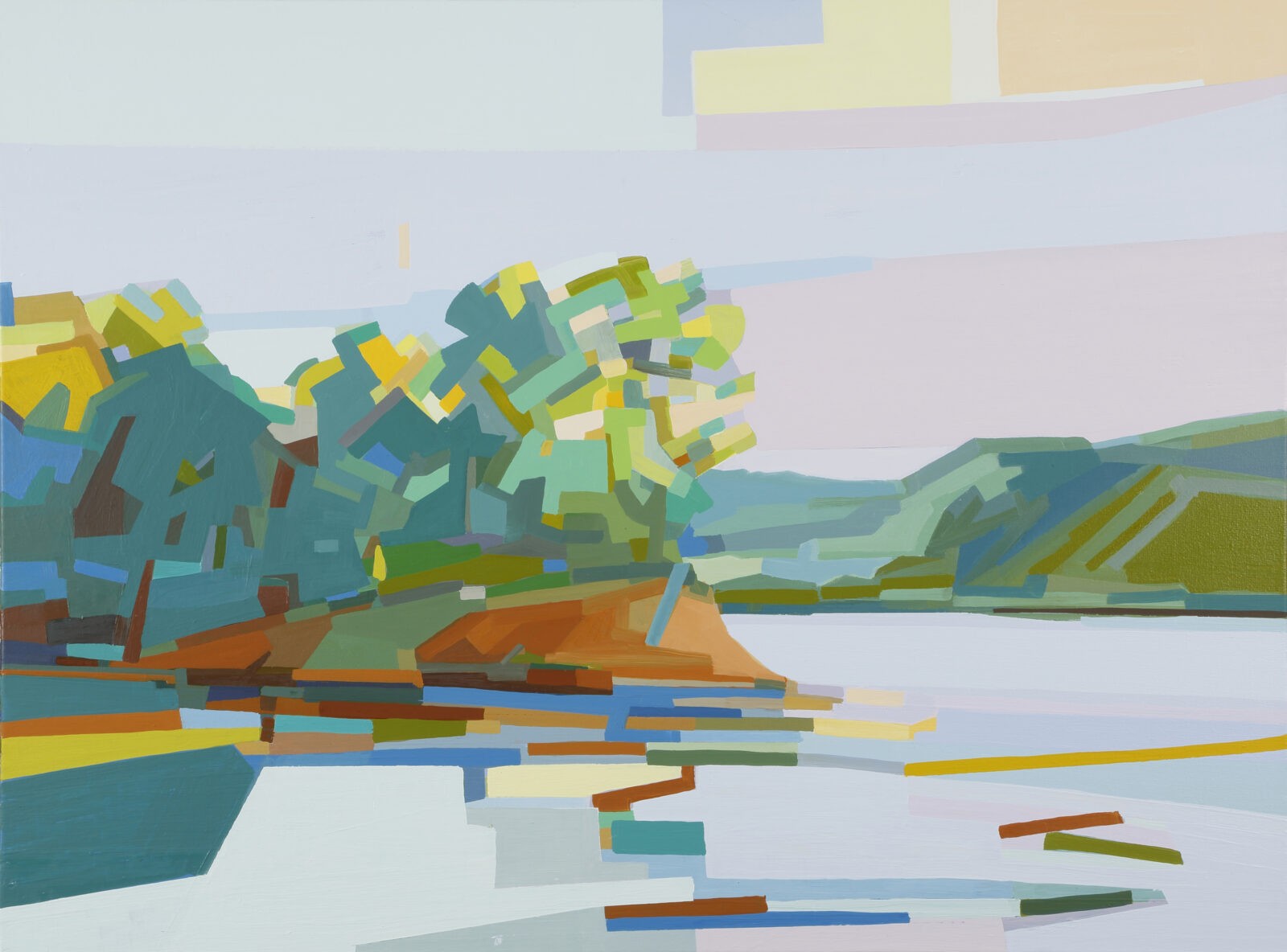
Sense of place is a discredited notion in contemporary criticism. Late-stage capitalism seems to be much more about a cacophony of mass-market, standardized erasable nowheres than any particular place. But Kleinhelter gives his works exact locations: “Mile 588;â€Â “Mile 581;†“Chute 18 Mile Island;†“12 Mile Island;†“Toward Westport.†(The mile titles are navigational references to locations on the 981-mile stretch of the Ohio River). Like the work of Martin Rollins, one of its pleasures is its re-definition of the local – but also its carefully crafted tension between artistic methods and ends, abstraction and representation, and the inevitable, deeply freighted, universal conversation about the state of our natural resources and their future.
“Ray Kleinhelter Paintings†is on view at the Kleinhelter Gallery, 701 East 8thStreet, New Albany, Indiana, through May 4th. “Ray Kleinhelter: Views from the River†is up until May 5th at Galerie Hertz, 1253 Preston Street, Louisville. The Kleinhelter exhibitions are participants in “Afloat: An Ohio River Way of Life.â€




